Week 1 : Mon 11 June – Sun 17 June
| Week 1: 11 – 17 June Tuesday 12 June Societe Jersiaise – all day |
Presentations, inspirations and workshop on exploring St Helier and looking at narrative using images in the collection of Percival Dunham
| Tuesday 12 June Societe Jersiaise – all day |
Presentations, inspirations and workshop on exploring St Helier and looking at narrative using images in the collection of Percival Dunham.
Blog: Produce a number of blog post that illustrate your knowledge and understanding. Use images , video and references to hyperlinks from sources used
- Describe your own view, feelings and vision for how you see the Future of St Helier.
- Define what a Masterplan is how it has influenced the development and planning of St Helier.
- Provide a brief history of St Helier and research the specific area of town that you have selected.
- Independent Study: Artists References/ Visual Inspiration. Research the Photo-Archive and select at least one photographer from the list provided that reference you chosen areas of study. Select at least one contemporary photographer that provides visual inspiration for your own shoots.
Photo-Archive
Dunham, Percy
Baudoux, Ernest
Smith, Albert
Henry Mullins
Archisle Contemporary Collection
Martin Parr (Liberation)
Michelle Sank (Insula)
Yury Toroptsov (Fairyland)
Tom Pope ( I am not Tom Pope, You are all Tom Pope)
Martin Toft ( Masterplan)
Lewis Bush
Click these links for access to the Photographic Archives
Societe Jersiaise Photographic Archives
Search the archive activity 2018
Follow these steps:
- Produce a mood board with a selection of images and write an overview of their work, why you have chosen them and how it may help develop your own ideas and shoots for your project.
- Select at least one image from each photographer and analyse in depth using methodology of DESCRIBE – INTERPRET – EVALUATE – CONTEXTUALISE.
- Make a detailed shooting plan on how you intend to respond to your research and chosen area of St Helier
Extension task: Select a second photographer from the Photo-Archive and a second contemporary photographer and follow the above instructions.
Deadline: Mon 17 June
MASTERPLAN
A masterplan is a dynamic long-term planning document that provides a conceptual layout to guide future growth and development. Master planning is about making the connection between buildings, social settings, and their surrounding environments. A master plan includes analysis, recommendations, and proposals for a site’s population, economy, housing, transportation, community facilities, and land use. It is based on public input, surveys, planning initiatives, existing development, physical characteristics, and social and economic conditions.
Example :
https://urban-regeneration.worldbank.org/node/51
North Of St Helier
Link to official Masterplan for the development of the North of St Helier
https://www.gov.je/Government/Pages/StatesReports.aspx?ReportID=583
Esplanade Quarter
Linsk to Masterplan for the Esplanade Quarter.
https://www.gov.je/Government/Pages/StatesReports.aspx?reportid=137
Review of the current Masterplan of the Waterfront
JERSEY DEVELOPMENT COMPANY
Jersey Development Company (JDC) is owned by the States of Jersey. It is responsible for completing the development of the St Helier Waterfront and regenerating States owned property no longer required for the delivery of public services.
You should : Explore their website and research a specific construction and build environment.
https://www.jerseydevelopment.je/
Website for the International Finance Centre Jersey that is under construction on the Esplanade
http://www.ifcjersey.je/about-ifc-jersey/
FUTURE OF ST HELIER
https://www.gov.je/PlanningBuilding/LawsRegs/IslandPlan/PlansFrameworks/pages/improvingsthelier.aspx
HISTORY OF ST HELIER
https://en.wikipedia.org/wiki/Saint_Helier
Here is a link to St Helier on Wikipedia which describes how the parish of is divided into 6 vingtaines for administrative purposes.
PSYCHO-GEOGRAPHY// SITUATIONISM
We have explored Psycho-geaography as a concept and way of working before…during the AS Landscape Project. Many of you succeeded in developing strong ideas by following some of the ideas.
Psycho-geography is a hybrid of photography and geography that emphasizes playfulness and “drifting” around urban environments. It has links to the Situationist International.
Psychogeography was defined in 1955 by Guy Debord as “the study of the precise laws and specific effects of the geographical environment, consciously organized or not, on the emotions and behavior of individuals.”
Another definition is “a whole toy box full of playful, inventive strategies for exploring cities… just about anything that takes pedestrians off their predictable paths and jolts them into a new awareness of the urban landscape.
The originator of what became known as unitary urbanism, psychogeography, and the dérive was Ivan Chtcheglov, in his highly influential 1953 essay “Formulaire pour un urbanisme nouveau” (“Formulary for a New Urbanism”).
It has roots in Dadaism and Surrealism.
The idea of urban wandering relates to the older concept of the flâneur, theorized by Charles Baudelaire…and is similar to STREET PHOTOGRAPHY
PETAPIXEL definition of PsychoGeography CLICK HERE

What to photograph and how
- Abstract visions…alternative, “wrong” photographs
- Formalism…line, shape, pattern, tone, colour etc
- Romanticism in the city…atmospherics
- The people : 3 x types of portrait (observatinal , formal, environmental)
- The objects | Ephemera (litter and debris)
- Make use of your senses : see , hear ,taste, smell, touch
- Old vs New vs Development
- Good vs bad…subjective approach
- Form vs function
- Gentrification vs dereliction
- Juxtaposition | contrasts | diversity
- Unconventional beauty
- Signage and facades
- Typography and graphics
- Movement / clutter
- Aerial Imagery / Satellite / Surveillance
- Angles | Viewpoints
Contemporary Approaches
Sohei Nishino : Diorama Maps
https://www.lensculture.com/articles/sohei-nishino-diorama-city-maps
Noemie Goudal : Nature vs Culture

Marcus Desieno creates de-humanised landscape photography by hacking surveillance camera networks…but avoids privacy problems normally associated with urban and residential areas…
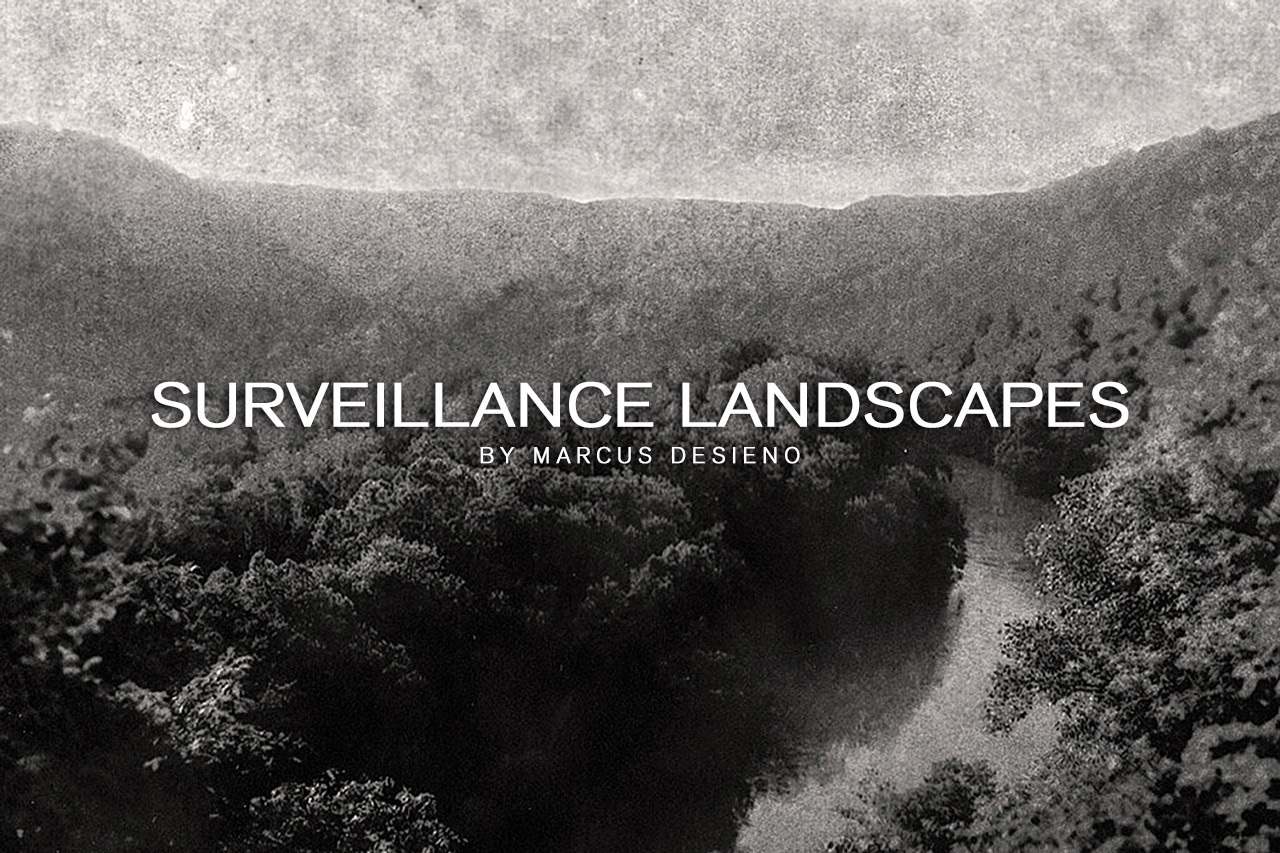
Letha Wilson : Merging shape and landscape

The Boyle Family : The ground we walk on

http://www.boylefamily.co.uk/boyle/about/index.html
Thom and Beth Atkinson : Scarred buildings
Missing Buildings: Thom and Beth Atkinson document the scars left on London by the Blitz
Mishka Henner : Aerial Imagery in the digital age

Luke Fowler: Two-Frame Film | Juxtapostions
http://www.photopedagogy.com/two-frame-films.html
Stephen Gill : “in-camera photograms”
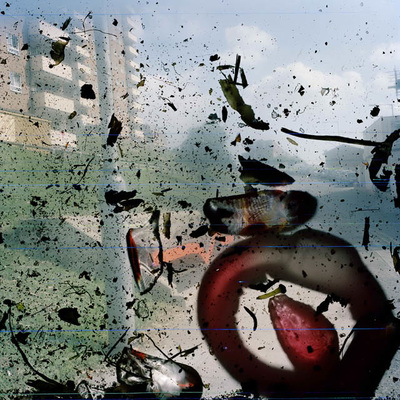
https://www.lensculture.com/articles/stephen-gill-outside-in
Joel Sternfeld: documenting the place and the people

https://www.joelsternfeld.net/artworks/2018/3/25/walking-the-high-line
John Bulmer: Working Class environments
Peter Mitchell: re-visiting locations throughout the years
http://www.bjp-online.com/2018/01/peter-mitchell-viking-4/
Typology means the study and interpretation of types and became associated with photography through the work of Bernd and Hilla Becher, whose photographs taken over the course of 50 years of industrial structures; water towers, grain elevators, blast furnaces etc can be considered conceptual art. They were interested in the basic forms of these architectural structures and referred to them as ‘Anonyme Skulpturen’ (Anonymous Sculptures.)
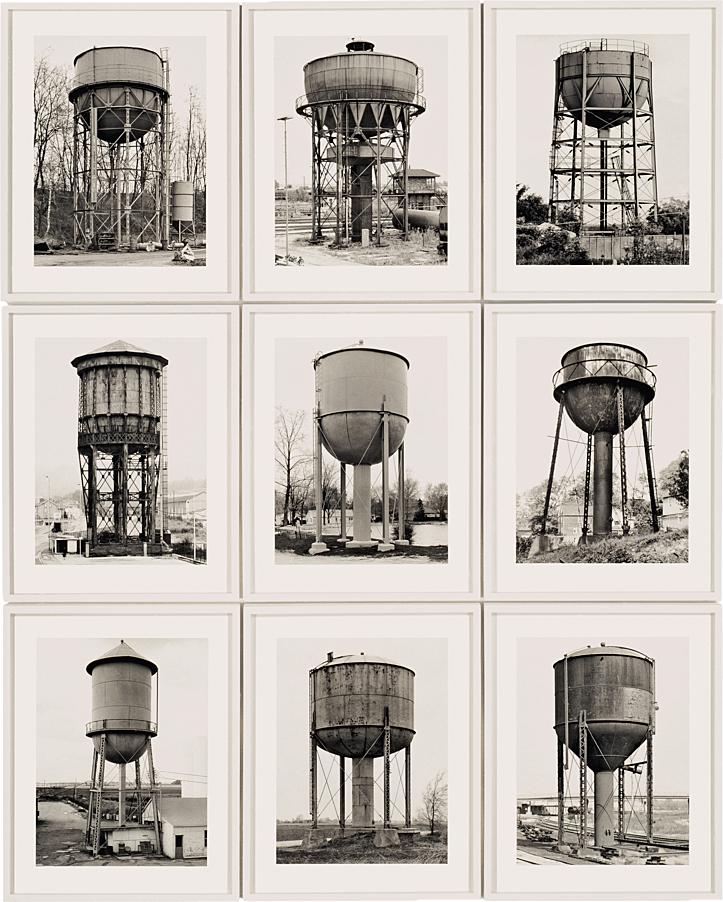
The Becher’s were influenced by the work of earlier German photographers linked to the New Objectivity movement of the 1920s such as August Sander, Karl Blossfeldt and Albert-Renger-Patzsch.
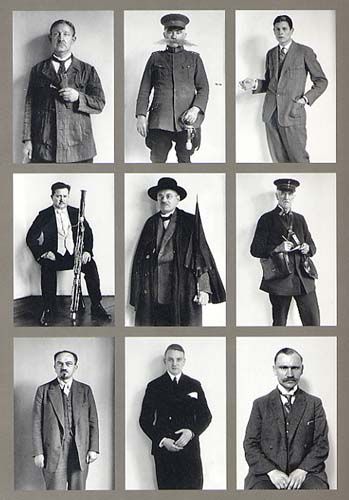


See also the work by Americans, William Christenberry and Ed Ruscha’s photographic works on types e.g. Twentysix Gasoline Stations (1964). Every building on the Sunset Strip (1966). Or Idris Khan‘s appropriation of Bechers’ images.




See previous blog post for more guidelines and a photo-assignment.
Not least of the Bechers’ legacy is their lasting influence on subsequent generations of artists who use the photographic medium today, most notably the students taught by Bernd Becher at the Düsseldorf Art Academy between 1976 and 1996. Among his most renowned students are Andreas Gursky, Candida Höfer, Thomas Ruff, and Thomas Struth.




From Germany, apart form the legacy of the Dusseldorf Kunst Akademie headed by the Becher’s another school of photography, the Werkstatt für Fotografie (Workshop for Photography) was founded in Berlin by Michael Schmidt who invited several leading American photographers, including William Eggleston and John Gossage, to teach there.

Responding to the wall between East and West in Berlin Schmidt produced a seminal work, Waffenrufe. Another body of work Berlin Nach 45 show empty streets of East Berlin made in the early hours as a quite testament to post war German architecture and urban city planning
Conceptual approaches to natural/ man-made environments
Tanja Deman is a Croation artist who was Archisle’s International Photographer-in-Residence in 2017.
Her art is inspired by her interest in the perception of space, physical and emotional connection to a place and her relationship to nature. Her works, incorporating photography, collage, video and public art, are evocative meditations on urban space and landscape. Observing recently built legacy or natural sites her work investigates the sociology of space and reflects dynamics hidden under the surface of both the built and natural environment.

Fernweh series explores the concept of a modernist city through its extreme relations to the landscape. The images are placed on a blurred line between a past which reminds us of a future and a future which looks like a past. Scenes are referring to the modernist ideas and aspiration of a man conquering the natural wild land and subordinating it to the rational order, and the consequences of those aspirations, which switched into the longing for an escape from urban environments.

Collective Narratives is a series staging a moment of contemplation of nature and built environment. Natural spectacles, framed in theatrical space are contemplated by an audience. These constructed images consolidate: geological formations; a projection of an urban environment; an arena; a deep chasm; a theatre and a crumbling slag-heap through a very active kind of watching.
While making the series ‘Collective Narratives’ I was interested in different types of spectatorship and architectural settings in which they are taking place. Moreover, the notion of a ritual in which a large group of people gathers and participates in order to experience something together by observing, intrigued me. I see these spaces for cultural and sports spectacles, as zones of pure potential, where the world must be rebuilt or re-imagined every time they are in use. Having liberated them from their utilitarian, commercial restrains, and the environments in which they were created, I allow them to cross the boundary of reality.
Together these scenes examine time and the strange modes of spectatorship attached to the inanimate world. A collective witnessing of phenomena that are usually experienced in private atmospheres.
Staged / Constructed Environments
Land art is art that is made directly in the landscape, sculpting the land itself into earthworks or making structures in the landscape using natural materials such as rocks or twigs

Land art was part of the wider conceptual art movement in the 1960s and 1970s. The most famous land art work is Robert Smithson’s Spiral Jetty of 1970, an earthwork built out into the Great Salt Lake in the USA. Though some artists such as Smithson used mechanical earth-moving equipment to make their artworks, other artists made minimal and temporary interventions in the landscape such as Richard Long who simply walked up and down until he had made a mark in the earth.

Land art, which is also known as earth art, was usually documented in artworks using photographs and maps which the artist could exhibit in a gallery. Land artists also made land art in the gallery by bringing in material from the landscape and using it to create installations.

As well as Richard Long and Robert Smithson, key land artists include Hamish Fulton, Walter de Maria, Michael Heizer, Dennis Oppenheim and Christo and Jeanne-Claude
Hamish Fulton (born 1946) is a British walking artist. Since 1972 he has only made works based on the experience of walks.

Read more here on Tate Online Resources
William Christenberry making typological studies of vernacular architecture traditional to the deep American South.
Christenberry also made little sculptures or 3D models of some of the buildings he had photographed
Photography and sculpture
Photographic installations which are site specific and 3-dimensional is very in vogue right now. In the exam paper starting point 4 is about artists exploring the material nature of a photographic image and the idea that photographs can be sculptural. Here are a few artists to explore
Felicity Hammond is an emerging artist who works across photography and installation. Fascinated by political contradictions within the urban landscape her work explores construction sites and obsolete built environments.



In specific works Hammond photographs digitally manipulated images from property developers’ billboards and brochures and prints them directly onto acrylic sheets which are then manipulated into unique sculptural objects. http://www.felicityhammond.com/
Lorenzo Venturi: Dalston Anatomy
Lorenzo Vitturi’s vibrant still lifes capture the threatened spirit of Dalston’s Ridley Road Market. Vitturi – who lives locally – feels compelled to capture its distinctive nature before it is gentrified beyond recognition. Vitturi arranges found objects and photographs them against backdrops of discarded market materials, in dynamic compositions. These are combined with street scenes and portraits of local characters to create a unique portrait of a soon to be extinct way of life.

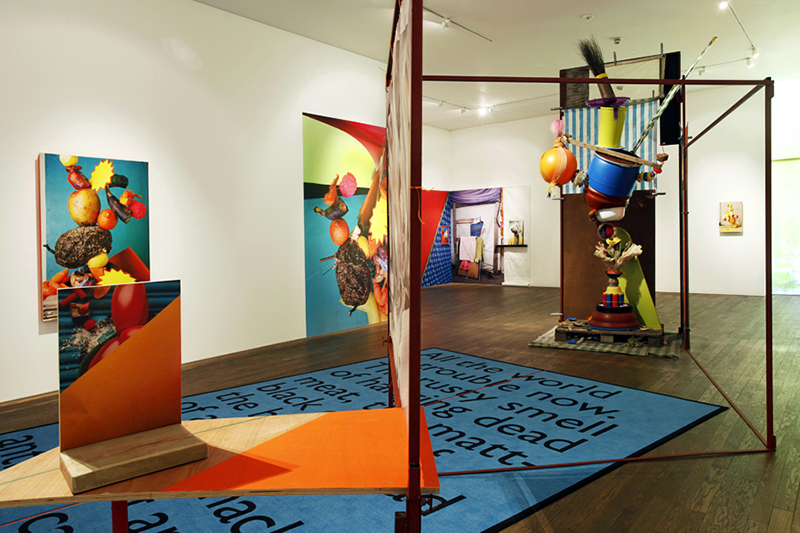
His installation at the Gallery draws on the temporary structures of the market using raw materials, sculptural forms and photographs to explore ideas about creation, consumption and preservation.
Watch our exclusive interview with Lorenzo.
Lorenzo Vetturi
http://www.lorenzovitturi.com/
Mishka Henner, Trevor Paglen, Doug Rickard, Daniel Mayrit all use found images from the internet, Google earth and other satellites images as a way to ask questions and raise awareness about our environment, state operated security facilities, social and urban neighbour hoods, prostitution, and London’s business leaders of major international financial institutions.

US oil fields photographed by satellites orbiting Earth.

Mishka Henner: I’m not the only one, 2015
Single channel video, 4:34 mins
Photographer Trevor Paglen has long made the advanced technology of global surveillance and military weaponry his subject. This year he has been nominated for the prestigious The Deutsche Börse Photography Foundation Prize which aims to reward a contemporary photographer of any nationality, who has made the most significant contribution (exhibition or publication) to the medium of photography in Europe in the previous year. The Prize showcases new talents and highlights the best of international photography practice. It is one of the most prestigious prizes in the world of photography. Read more here

Doug Rickard is a north American artist / photographer. He uses technologies such as Google Street View and YouTube to find images, which he then photographs on his monitor, to create series of work that have been published in books, exhibited in galleries.
Months after the London Riots in 2008 (at the beginning of the economical crash) the Metropolitan Police handed out leaflets depicting youngsters that presumably took part in riots. Images of very low quality, almost amateur, were embedded with unquestioned authority due both to the device used for taking the photographs and to the institution distributing those images. But in reality, what do we actually know about these people? We have no context or explanation of the facts, but we almost inadvertently assume their guilt because they have been ‘caught on CCTV’.
In his awarding book: You Haven’s Seen the Faces.. Daniel Mayrit appropriated the characteristics of surveillance technology using Facebook and Google to collect images of the 100 most powerful people in the City of London (according to the annual report by Square Mile magazine in 2013). The people here featured represent a sector which is arguably regarded in the collective perception as highly responsible for the current economic situation, but nevertheless still live in a comfortable anonymity, away from public scrutiny.
Read article here in the BJP on Shooting the Rich
Read and see more here on his website and the publisher, RIOT Books
See also this book Looters by Tiane Doan Na Champassak
Another Kind of Life: Photography on the Margins
At a time of significant national and global uncertainty, the season in 2018 at the Barbican Art Gallery in London explore how artists respond to, reflect and potentially effect change in the social and political landscape.
Reflecting a diverse, complex and authentic view of the world, the exhibition touches on themes of countercultures, subcultures and minorities of all kinds, the show features the work of 20 photographers from the 1950s to the present day. Diane Arbus, Casa Susanna, Philippe Chancel, Larry Clark, Bruce Davidson, Mary Ellen Mark, Paz Errázuriz, Jim Goldberg, Katy Grannan, Pieter Hugo, Seiji Kurata, Danny Lyon, Teresa Margolles, Boris Mikhailov, Daido Moriyama, Igor Palmin, Walter Pfeiffer, Dayanita Singh Alec Soth and Chris Steele-Perkins
Read Press Release here
Paz Errázuriz The beautifully arresting series of photographs, Adam’s Apple (1982-87), by Chilean photographer Paz Errázuriz are of a community of transgender sex-workers working in an underground brothel in Chile in the 1980s. Taken during the military dictatorship of General Augusto Pinochet when gender non-conforming people were regularly subjected to curfews, persecutions and police brutality, the photographs are a collaborative and defiant act of political resistance.

 Read review here in Dazed and Confused and a gallery page in the Guardian
Read review here in Dazed and Confused and a gallery page in the Guardian
Lewis Bush: Archisle Photographer-in-Residence 2018 is a Photographer, Writer, Curator and Educator based in London. After studying History and working as a researcher for the United Nations Taskforce on HIV/AIDS he completed a MA in Documentary Photography at the London College of Communication in 2012. Since then he has developed a multifaceted practice encompassing photography, writing and curation to explore ideas about the way power is created and exercised in the world. In The Memory of History (2012) he travelled through ten European countries documenting the way the past was being manipulated in the context of the economic crisis and recession. This project was widely published and was exhibited at the European Union’s permanent representation in London in 2014. More recent works include Metropole (2015) which critiques the architectural transformation of London and the city’s growing inequality by subverting the imagery of London’s luxury and corporate developments. Bush’s new book Shadows of the State (2018) uses open source research to reveal numbers stations, cold war intelligence communications which remain in use today. Bush is a Lecturer on the MA and BA(hons) Documentary Photography Programmes at London College of Communication.




Read Lewis Bush blog Disphotic here
City and abstraction:
Aaron Siskind
Ernst Haas
Saul Leiter
Street Photography:
Beat Streuli
Canon of american street photography Walker Evans and his project Labour Anonymous Robert Frank Lee Friedlander Gary Winogrand Diane Arbus William Eggleston Stephen Shore
Jim Goldberg
Eamon Doyle: trilogy from Dublin
The City at Night:
Rut Blees Luxembourg
Maciej Dakowicz: Cardiff at Night
Todd Hido
Saul Leiter
Daniel
Last year Tom Pope came to Jersey for a 6 month residency with Archisle in the Photographic Archive of the Société Jersiaise, Jersey and produced an exhibition and installation I Am Not Tom Pope, You Are All Tom Pope featuring a number of diverse and new work incorporating elements of photography, performance, video and sculpture. Go to his website to see examples of his unique work. Here are some of the key concepts that underpin’s his work and practice:
Performance, Photography, Chance, Humour/Fun, Repetition
Play, Psychogeography, dérive (drifting), Situationism, Dadaism
Public/Private, Challenging authority, Failure, DIY/Ad-hoc approach, Collaboration, Audience participation
Here are a list of other artists/ photographers that has influenced Tom Pope’s work and that may inspire you: Vito Acconci, John Baldessari, Yves Klein, Bas Jan Ader, Erwin Wurm, Chris Arnatt, Richard Long, Hamish Fulton, Joseph Beuys, Chris Burden, Francis Alÿs, , Sophie Calle , Nikki S Lee, Claude Cahun, Dennis Oppenheim, Bruce Nauman, Allan Kaprow, Mark Wallinger, Gillian Wearing, Sam Taylor-Johnson, Steve McQueen, Marcel Duchamp and the Readymade, Andy Warhol’s film work, Marina Abramovic, Pipilotti Rist, Luis Bunuel/ Salvatore Dali: , Le Chien Andalou, Dziga Vertov: The Man with a Movie Camera
John Baldessari: “I will not make any more boring art…”
Homework Assignment 1
Contextual Studies : Research
Homework Assignment 2
Night Shoot : St Helier
Homework Assignment 3
Provoke : Japan
Homework Assignment 4
Looking at Photo-Book / Zine Design
Homework Assignment 5
Presentation methods








